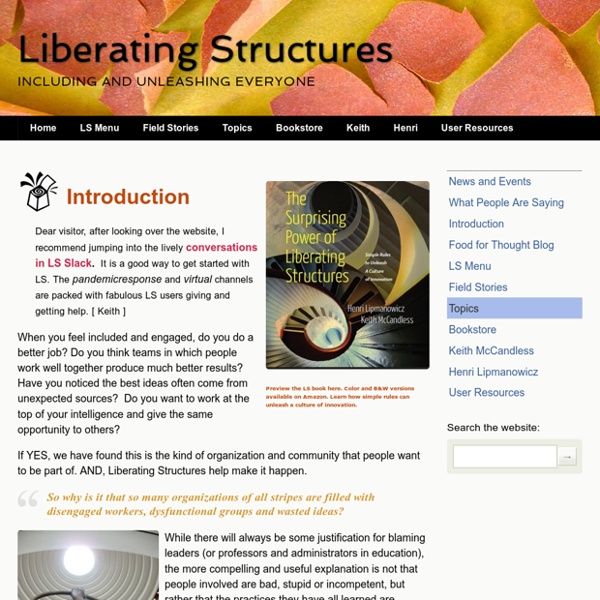



http://www.liberatingstructures.com/
Related: Creative Thinking • Management - Leadership • AGILE MINDSETA List of Excellent Student Design Projects for Middle School Creativi – Wabisabi Learning Student design projects come alive in any classroom environment with the right kind of tools. Seeing creativity and understanding blossom is the pride of every teacher. Kids love to show creative prowess in projects with real-world applications. To do this they need awesome digital tools to explore and work with. Principles Principles LS principles guide our behavior as we decide that we belong together. The ten leadership Principles below highlight what becomes possible when LS are used to structure everyday interactions. Everyday interactions mean meetings, one-on-one conversations, change initiatives, and interactions with clients. Principles are rules governing how we can choose to relate to others.
Scrum Guide Revisions Even Less PrescriptiveOver the years, the Scrum Guide started getting a bit more prescriptive. The 2020 version aimed to bring Scrum back to being a minimally sufficient framework by removing or softening prescriptive language. e.g. removed Daily Scrum questions, soften language around PBI attributes, soften language around retro items in Sprint Backlog, shortened Sprint cancellation section, and more. One Team, Focused on One ProductThe goal was to eliminate the concept of a separate team within a team that has led to “proxy” or "us and them” behavior between the PO and Dev Team. 28617911-Web-Crawler There are important characteristics of the Web that make crawling very difficult: Its large volume, Its fast rate of change, and Dynamic page generation.These characteristics combine to produce a wide variety of possible crawlable URLs.The large volume implies that the crawler can only download a fraction of the Web pages withina given time, so it needs to prioritize its downloads.
Introducing Something New At Work? Think About This. It's your idea. You've thought about it--most likely for a long time. You've weighed the risks and benefits. You've visualized what things would look like if your new idea/project/improvement is implemented. You've even thought about at least some of the details. But most of all. . . Promoting Critical Thinking In Online Courses contributed by Rosa Fattahi, WizIQ Since the ancient days of philosopher Socrates, asking questions has been a critical part of the teaching and learning process. The well-known question-and-answer technique that Socrates employed with his pupils demonstrated how well dialogue and discourse work to stimulate students, encourage more complex thinking, and help them learn. For educators, verbal questioning also helps foster a sense of community in the classroom and keeps students engaged in the instructional process. Thus, in order to maintain active classroom dialogue and encourage student involvement, it is important for teachers to understand and employ effective questioning techniques. Questions are invaluable teaching tools that serve many functions in the teaching and learning processes.
Creating the Best Workplace on Earth Suppose you want to design the best company on earth to work for. What would it be like? For three years we’ve been investigating this question by asking hundreds of executives in surveys and in seminars all over the world to describe their ideal organization. Management 3.0 Practice for better Teams Different situations require different decision-making processes within teams and there are a variety of ways that decisions can be made. They can be made by one person or carried out by the whole team. The question is when to use which approach and how will the team decide? This is where the decision model comes in. Cancer the secret weapon? It was a case destined for the X-Files and conspiracy theorists alike, when Venezuelan president Hugo Chavez speculated that the US might have developed a way to weaponise cancer, after several Latin American leaders were diagnosed with the disease. The list includes former Argentine president, Nestor Kirchner (colon cancer) Brazil’s president Dilma Rousseff (lymphoma cancer), her predecessor Luiz Inacio Lula da Silva (throat cancer), Chavez (undisclosed), former Cuban president Fidel Castro (stomach cancer) Bolivian president, Evo Morales (nasal cancer) and Paraguayan president Fernando Lugo (lymphoma cancer). What do they have in common besides cancer?
What Does the Agile Manifesto Mean? As we all know, the Agile Manifesto was authored at a ski lodge in Utah in 2001. These important guidelines and principles drive much of what we do. These simple, elegant words are very difficult to use in the real world and sometimes, in my opinion, are misunderstood. I thought I would write some words about Agile from the direct perspective of the Agile Manifesto. PZ's Thinking Routines Toolbox Welcome to Project Zero’s Thinking Routines Toolbox. This toolbox highlights Thinking Routines developed across a number of research projects at PZ. A vast array of PZ's work has explored the development of thinking, the concept of thinking dispositions, and the many ways routines can be used to support student learning and thinking across age groups, disciplines, ideals, competencies, and populations. Thinking Routines originated in PZ’s Visible Thinking research initiative. Over the years, researchers enhanced and expanded upon the original routines, and new projects developed new routines.
businessinsider.com Today’s business world is as complex as ever. And it’s always changing. Ray Carvey, executive vice president of corporate learning at Harvard Business Publishing, a subsidiary of the Harvard Business School, says management structures today are very different than 20 years ago, namely because of the middle manager. Carvey describes today’s business world as “volatile, uncertain, complex, and ambiguous,” and says it’s crucial to stay productive through this time of change. According to Harvard Business Publishing’s recent report, “Leading Now: Critical Capabilities for a Complex World,” there are eight critical capabilities leaders must possess to be effective today.